Meissen 'Kakiemon' style from the Hoffmeister Collection @ Bonhams on november 25
A very rare Meissen armorial plate with the Saxon-Polish coat of arms from the 'Coronation Service', circa 1733-34
The arms within an elaborate gilt trefoil escutcheon surmounted by a Royal Crown, supported by Böttger lustre strapwork flanked by gilt palms and drapery, surrounded by scattered indianische Blumen and Kakiemon wheat-sheaves, the rim with a broad band of elaborate gilt scrollwork, 22.7cm diam., crossed swords mark in underglaze-blue, impressed Dreher's mark for Johann Christoph Pietzsch Senior, incised Japanese Palace inventory number N=147-W - Sold for £24,000
Provenance: The Royal collections of Saxony, Japanese Palace, Dresden (from 1734);
Anon. Sotheby's London, 29 June 1982, lot 120
Literature: Hoffmeister 1989, II, no. 344
Exhibition: Hamburg, Museum für Kunst und Gewerbe, 1999-2009
A lack of archival evidence means that it remains uncertain whether this service was ordered by Augustus the Strong before his death on 1 February 1733, or by his son in anticipation of his election to the Polish throne in Warsaw in January 1734. The prominence of the Polish arms perhaps suggests the latter, though the name 'Coronation service' is a 19th-century title.
The service was delivered to the Japanese Palace in Dresden in 1734, when, according to a delivery specification (published by Boltz 1996, p. 91), it comprised 77 parts in total, including 37 plates. In the inventory of the Japanese Palace of 1770 (Boltz 1996, p. 76), one finds the following entry under number 147: 'Ein Tafel-Service, mit dem Königl. Pohlnis, und ChurFürstl. Sächsi. Wappen, fein mit Golde und Zierrathen, aufm Boden mit gebundenen Korn-Aehren, und kleinen Blümgen, der Rand sehr reich mit vergoldeten Zierrathen eingefaßt' (a table service with the Royal Polish and Electoral Saxon arms, fine with gold and decorations, with bundles of corn sheaves and small flowers on the surface, the rim with very rich gold decorations). The inventory lists the same pieces as the 1734 delivery specification, except for three missing tureens and a broken plate. According to the catalogue of the Wark Collection catalogue, part of the service was transferred to the Hofconditorei (court pantry) in 1792, and was used at the Dresden Residence for special court functions (Wark 1984, p. 225).
In addition to the examples cited by Dieter Hoffmeister (Literature), other plates from the service are in the Seattle Art Museum (inv. no. 69.201, gift of Martha and Henry Isaacson); in the Ludwig Collection, Bamberg (Hennig (ed.) 1995, no. 142); and in the Arnhold Collection, New York (Cassidy-Geiger 2008, no. 186).
An extremely rare Meissen plate, circa 1735
Decorated with a phoenix-like bird seated on a gold lined branch amongst large Kakiemon flowers, the rim with three Kakiemon flower sprays and scattered small flowers, 23.5cm diam., crossed swords mark in underglaze-blue (very minor wear to the gilt rim and enamels) - Sold for £16,800
Provenance: Acquired in 1989
Literature: Hoffmeister 1999, I, no. 142
Exhibited: Hamburg, Museum für Kunst und Gewerbe, 1999-2009
A rare Meissen dish, circa 1730
Of oblong shape, painted in Kakiemon style with wheat sheaves and scattered indianische Blumen over an elaborate diaper pattern, the reverse painted with scattered flowers, 20.3cm wide, caduceus mark in underglaze-blue - Sold for £9,600
Provenance: Acquired in 1984
Literature: Hoffmeister 1999, I, no. 163
Exhibited: Hamburg, Museum für Kunst und Gewerbe, 1999-2009
Another dish of this shape but with a diagonal decoration is illustrated in the catalogue of Meissen Porcelain from a private collection in Bad Pyrmont (Lemcke 2002, p.75). A highly comparable dish of the same shape but with a diagonal brocade pattern of lozenges and flying fox and squirrel among banded hedges was sold at Christie's London, 10 July 2007, lot 74.
A rare Meissen circular dish, circa 1735
The well painted in Kakiemon style with a butterfly over flowering plants issuing from stylised rockwork, the rim with an underglaze-blue trellis border reserved with four gilt-edged panels painted with sprigs of indianische Blumen, 33.2cm diam., crossed swords mark in underglaze-blue - Sold for £6,000
Provenance: Anon. sale, Christie's London, 30 September 1991, lot 177;
Acquired in the above sale
Literature: Hoffmeister 1999, I, no. 150
Exhibited: Hamburg, Museum für Kunst und Gewerbe, 1999-2009
A large Meissen armorial dish from the Hennicke service, circa 1735-38
Painted with scattered indianische Blumen surrounding a central medallion with a Kakiemon landscape, centred at the top with the coat-of-arms surrounded by gold and blue scrollwork, the arms surmounted by a gold rampant lion flanked by two blue and red and black and gold wings, brown-edged wavy rim, 38.8cm diam., crossed swords mark in underglaze-blue, incised 4 inside the footrim, impressed Dreher's mark for Johann Christoph Pietzsch - Sold for £6,000
Provenance: Acquired in 1979
Literature: Hoffmeister 1999, II, no. 350
Exhibited: Hamburg, Museum für Kunst und Gewerbe, 1999-2009
Johann Christian Hennicke (1681-1752) was raised to the nobility in 1728 by the Holy Roman Emperor. He was an influential Cabinet Minister under Count Brühl, and became deputy director of the Meissen factory in 1739. The arms on this service go back to before he was made Freiherr or Baron, in 1741, and Graf or Count, in 1745.
Although pieces from the service have occasionally appeared on the market, only two other pieces of this size have been sold: one from the collection of Dr. Marcel Nyffeler, Zürich (Christie's London, 9 June 1986, lot 119) and Sotheby's New York, 26 September 1989, lot 110. Recent examples from this service to appear on the market include: a tureen stand (Christie's London, 11 December 2000, lot 437); two spoons (Christie's New York, 18 October 2002, lot 432); and a tureen (Christie's London, 14 July 2006, lot 100). A tureen with applied flowers from the service was sold at Bonhams in London, 10 November 2004, lot 18. Two sauce boats and a spoon from the service are in the Rijksmuseum, Amsterdam (Den Blaauwen 2000, nos. 110 and 111), and a pair of dishes is in the Arnhold Collection, New York (Cassidy-Geiger 2008, nos. 202a and b).
A large Meissen saucer, circa 1730
Painted in Kakiemon style with two quail flanked by flowering prunus and other flowers, brown-edged rim, 15cm diam., crossed swords mark in blue enamel, incised Japanese Palace inventory number N=326-/ W - Sold for £5,760
Provenance: The Royal Collections of Saxony, Japanese Palace, Dresden;
Acquired in 1979
Literature: Hoffmeister 1999, I, no. 120
Exhibited: Hamburg, Museum für Kunst und Gewerbe, 1999-2009
The 1770 inventory of the Japanese Palace records under no. 326 'Ein Dutzendt und 8. Stück runde Chocolaten Becher, mit bunten Blumen und Rebhünern, nebst Sieben dergleichen Unterschaalen ... die Schaalen 1 1/2. Zoll hoch, 6. Zoll in Diam (A dozen and eight round chocolate beakers, with coloured flowers and partridges, with seven similar saucers ... the saucers 1 1/2 Zoll high, 6 Zoll diam.) (quoted by Boltz 1996, p. 56).
A Meissen yellow-ground teabowl and saucer, circa 1730-35
Each reserved on the yellow ground with branches of indianische Blumen, the saucer painted in Kakiemon style with flowers issuing from a stylised rockwork and a bird in flight, the well of the teabowl with a flower, brown-edged rims, the saucer: 12.2cm diam., the teabowl: 4.3cm high, caduceus (teabowl) and crossed swords (saucer) marks in underglaze-blue, impressed Dreher's marks for Caspar Meißner (teabowl) and an asterisk (saucer) (2) - Sold for £5,400
Provenance: Acquired in 1976
Literature: Hoffmeister 1999, II, no. 284
Exhibited: Hamburg, Museum für Kunst und Gewerbe, 1999-2009
A Meissen lobed beaker, circa 1730
Painted in Kakiemon style with a Chinese boy carrying a flower vase on his back and another seated with a fan, 5.5cm high, crossed swords mark in blue enamel, incised Japanese Palace inventory number N=362/ W - Sold for £4,800
Provenance: The Royal Collections of Saxony, Japanese Palace, Dresden;
The Property of a Danish Lady, Christie's London, 1st March 1993, lot 181
Acquired in the above sale
Literature: Hoffmeister 1999, I, no. 41
Exhibited: Hamburg, Museum für Kunst und Gewerbe, 1999-2009
The 1770 inventory of the Japanese Palace records: "Acht und Dreyßig Stück gemuschelte Theé Copgen, mit Pagoden gemahlt, 2 1/4. Zoll hoch, 3. Zoll in Diam: no. 362" (thirty-eight lobed teabowls, painted with pagodas...) (quoted by Boltz 1996, p. 58).
A rare Meissen plate, circa 1735
Painted in Kakiemon style with two cranes facing a flowering bush with a bird and butterfly in flight, the rim moulded with a 'Sulkowski-Ozier' pattern, painted with scattered sprigs, 23.5cm diam., crossed swords mark in underglaze-blue - Sold for £4,320
Provenance: Sir David Ogilvy, Bt., sold Christie's London, 16 October 1972, lot 130 (part);
With Delomosne;
Anon. sale, Christie's Geneva, 11 November 1985, lot 113;
Acquired in the above sale
Literature: Hoffmeister 1999, I, no. 131
Exhibited: Hamburg, Museum für Kunst und Gewerbe, 1999-2009
A rare Meissen stand, circa 1730-35
Of shaped rectangular form, painted in Kakiemon style with indianische Blumen issuing from stylised rockwork, a butterfly and scattered flowers around the brown-edged rim, the reverse with scattered iron-red flower sprigs, 16.1cm by 15.5cm, crossed swords mark in underglaze-blue, incised x (probably for Johann Christoph Pietzsch) - Sold for £4,200
Provenance: Anon. sale, Sotheby's London, 14 June 1983, lot 105;
Acquired in the above sale
Literature: Hoffmeister 1999, I, no. 156
Exhibited: Hamburg, Museum für Kunst und Gewerbe, 1999-2009
A Meissen plate from the Podewils service, circa 1741-42
Of hexafoil shape, decorated with scattered Kakiemon flowers and a central coat of arms with an escutcheon surrounded by the Order of the Black Eagle, surmounted by a gilt coronet and flanked by two black eagle supports each with crowned FR monogram, standing on gilt and red scrolling supports, the double gilt line around the moulded rim interspersed with five gilt moulded shells at the corners, 30.5cm diam., crossed swords mark in underglaze blue, impressed 21, gilt P. inside footrim - Sold for £4,080
Provenance: Given by Augustus III of Poland and Saxony to the Prussian envoy, Heinrich Graf von Podewils, probably in 1742;
Acquired in 1976 from Andreina Torré, Zürich
Literature: Hoffmeister 1999, II, no. 356
Exhibited: Hamburg, Museum für Kunst und Gewerbe, 1999-2009
Heinrich von Podewils (1695-1760) entered Prussian service in 1720 and, together with his two brothers, was raised to the rank of Graf (Count) in 1741. He was Prussian envoy in Copenhagen and Stockholm in 1728-29, and subsequently was Prussian negotiator following the Silesian wars, signing the peace treaties of Breslau (1742) and Dresden (1745). It was probably in connection with the First Silesian War that Podewils was sent by the newly crowned King of Prussia, Frederick the Great, on a mission to Dresden, where he arrived on 15 November 1741. Podewils himself recorded in a memoir, "as of the end of 1741, I was posted by His Royal Majesty to the court of Dresden where, after having successfully accomplished my commission, the King in Poland most graciously made me a gift of a portrait of himself, lavishly set with diamonds, and a costly porcelain table service" (quoted in Wittwer 2007, p. 101).
The shapes for the service had been developed around the same time for the Elector Clemens August of Cologne (Hoffmeister 1999, II, no. 361), and a handful of slightly later examples with simple flower painting have also survived (see lot 71). Dr. Wittwer speculates (op. cit., p. 102) that the Podewils service decoration of indianische Blumen may originally have been intended for the Elector, who preferred more European flowers. The design may then have been adapted for Podewils, perhaps because the service was urgently required. Additions to the service appear to have been ordered at Meissen, and at the Berlin manufactory after Podewils' death. In a letter to Karl-Wilhelm Finck von Finckenstein, Frederick the Great wrote of Podewils after his death: "I regret very much poor Podewils. He was a man of honour and a good citizen. The loss of such a worthy and faithful servant will always remain a sorrowful memory" (quoted in Hoffmeister 1999, II, p. 608). Only five plates of this size were recorded in the collection of Ole Olsen, which included over 100 pieces from this service, and was sold in Copenhagen between 1943 and 1953. Another large dish (35.3cm diam.) is in the Rijksmuseum, Amsterdam (Den Blaauwen 2000, no. 117).
A Meissen leaf-shaped dish, circa 1740
Painted in Kakiemon style with a red squirrel above banded hedges with indianische Blumen and another yellow squirrel, brown-edged rim, 24.1cm wide, crossed swords mark in underglaze-blue, impressed 26 - Sold for £3,840
Provenance: Acquired in 1977
Literature: Hoffmeister 1999, I, no. 117
Exhibition: Hamburg, Museum für Kunst und Gewerbe, 1999-2009
A Meissen price list of 1731 refers to such dishes as 'ovale platte Muscheln zum Confect in Form eines doppelten Blattes' (an oval dish shell for confectionary in the form of a double leaf) (quoted by Hoffmeister loc. cit.).
A Meissen plate, circa 1740
Painted in Kakiemon style with the 'Three Friends of Winter', with flowering prunus, bamboo and pine branches issuing from banded hedges, a bird perched on one branch and another in flight, the brown-edged rim painted with scattered indianische Blumen and wheat sheaves, 22.5cm diam., crossed swords mark in underglaze-blue, impressed 22 - Sold for £3,360
Provenance: Acquired in 1991
Literature: Hoffmeister 1999, I, no. 148
Exhibited: Hamburg, Museum für Kunst und Gewerbe, 1999-2009
A Meissen cup and saucer, circa 1730-35
Of lobed form with barbed rims, painted in Kakiemon style with a bird in flight and a sprig of indianische Blumen, the saucer: 13.8cm wide; the cup: 5.4cm high, crossed swords marks in blue enamel (saucer) and underglaze-blue (cup) (2) - Sold for £3,120
Provenance: Acquired in 1991
Literature: Hoffmeister 1999, I, no. 124
Exhibited: Hamburg, Museum für Kunst und Gewerbe, 1999-2009
Two similar cups and saucers with blue enamel crossed swords marks in the Grassi Museum, Leipzig, are marked with the Japanese Palace inventory number 'N=365-' (Gielke 2003, nos. 54 and 55). The 1770 inventory of the Japanese Palace (published by Boltz 1996, p. 58), lists under no. 365: 'Fünf Dutzend und 4. Stück ovale geschweiffte Thée Tassen, mit einem Henkel, mit rothen Vögeln und Blümgen gemahlt, 2. Zoll tief, 3 1/4 Zoll in Diam: und Fünf Dutzend und 3. Stück detto Unterschaalen, 1. Zoll tief, 5 3/4. Zoll lang, 5 3/4. Zoll in Diam: No. 365' (five dozen and four oval wavy tea cups, with one handle, painted with red birds and flowers [...]: and five dozen and three similar saucers...).
A Meissen purple-ground teacup and saucer, circa 1745
Painted in Kakiemon style with two quail flanked by flowering plants, on the teacup within a purple-edged, shaped quatrelobe reserve, the purple ground reserved with indianische Blumen and a foliate band interspersed with flowers, brown-edged rims, the handle embellished in purple, the saucer: 13cm diam, the cup: 4.8cm high, crossed swords marks in underglaze-blue, impressed 11 (cup) and 4 (saucer) (2) - Sold for £2,400
Provenance: Acquired in 1993
Literature: Hoffmeister 1999, II, no. 287
Exhibited: Hamburg, Museum für Kunst und Gewerbe, 1999-2009
Another cup and saucer of the same pattern and ground colour was sold at Christie's London, 14 July 2006, lot 103.
A Meissen plate, circa 1740
Painted in Kakiemon style with a bird in flight over indianische Blumen and banded hedges issuing from stylised rockwork, the wavy brown-edged rim with three flower sprigs, 23.7cm diam., crossed swords mark in underglaze-blue, impressed 16, 'H' or 'HM' in purple and gilding - Sold for £1,680
Provenance: Acquired in 1977
Literature: Hoffmeister 1999, I, no. 127
Exhibited: Hamburg, Museum für Kunst und Gewerbe, 1999-2009
A Meissen plate, circa 1735
Painted in Kakiemon style with the 'koreanischer Löwe' pattern of a stork and a winged dragon above a flowering bush and a beetle, the rim moulded with the Sulkowski-Ozier pattern and painted with sprigs of indianische Blumen and insects, 22.5cm diam., crossed swords mark in underglaze-blue, impressed Dreher's mark of two dots (for Johann Martin Kittel) - Sold for £1,440
Provenance: Acquired in 1980
Literature: Hoffmeister 1999, I, no. 122
Exhibited: Hamburg, Museum für Kunst und Gewerbe, 1999-2009
Bonhams. The Hoffmeister Collection of Meissen Porcelain Part 1, 25 Nov 2009. New Bond Street www.bonhams.com © 2002-2009 Bonhams 1793 Ltd

/https%3A%2F%2Fprofilepics.canalblog.com%2Fprofilepics%2F1%2F0%2F100183.jpg)
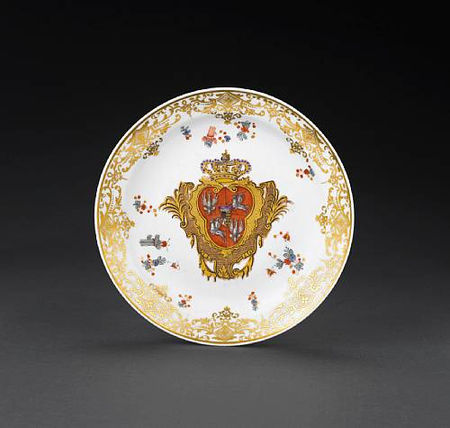
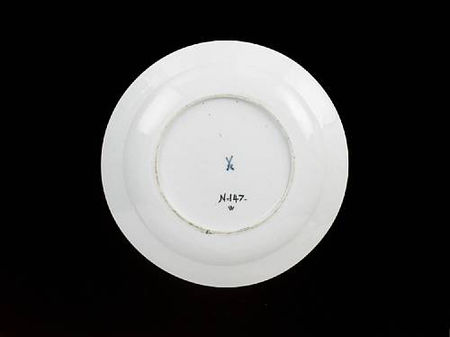
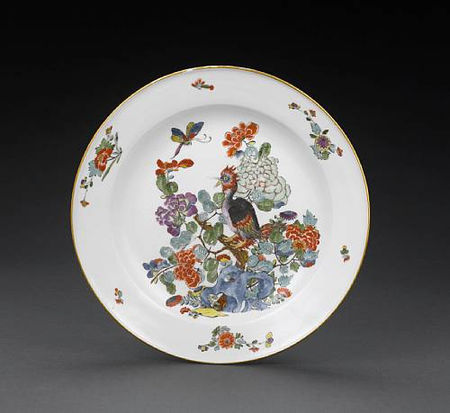

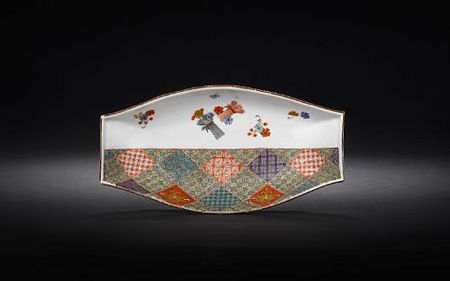
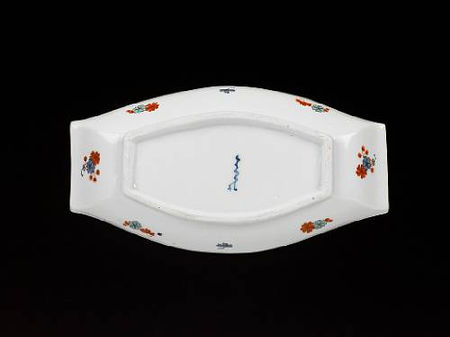

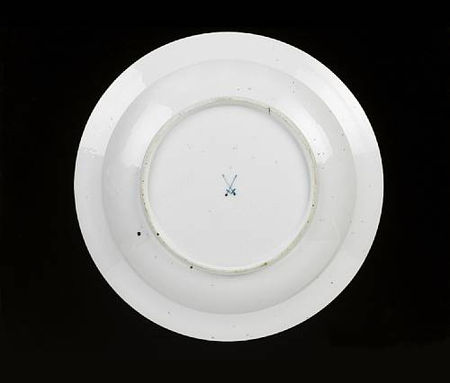

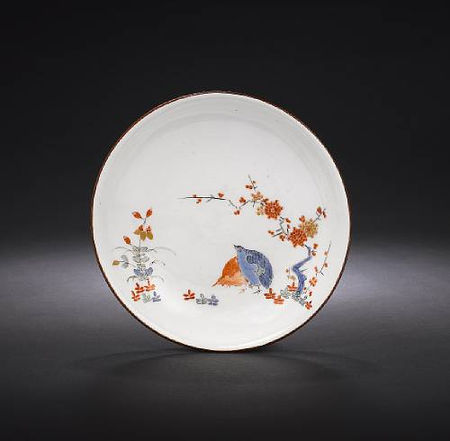





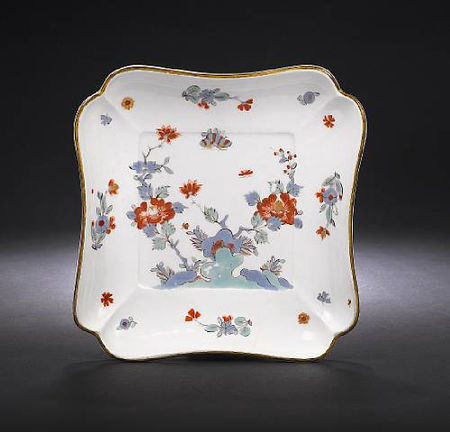
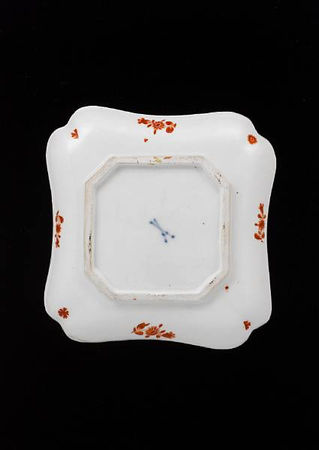
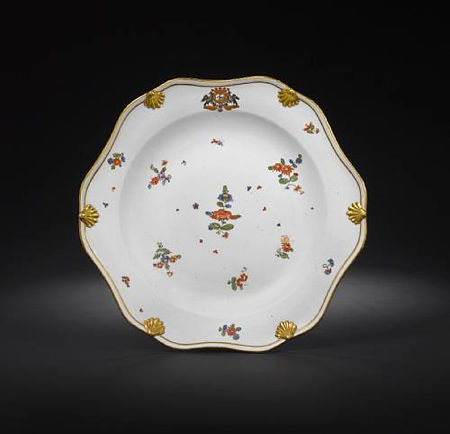
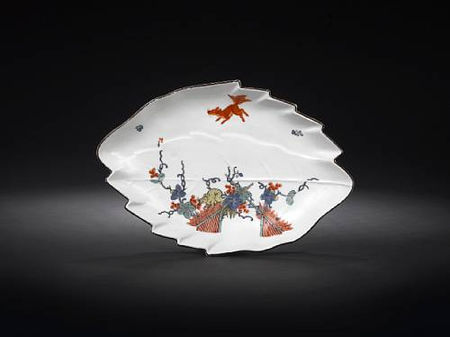
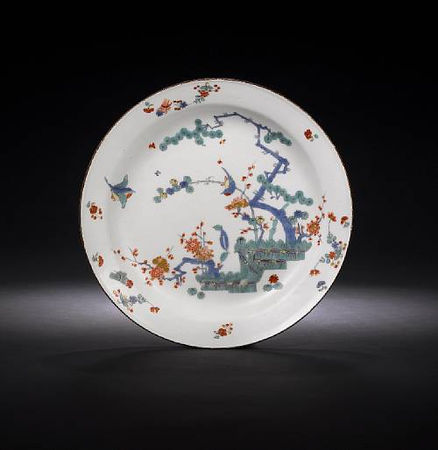
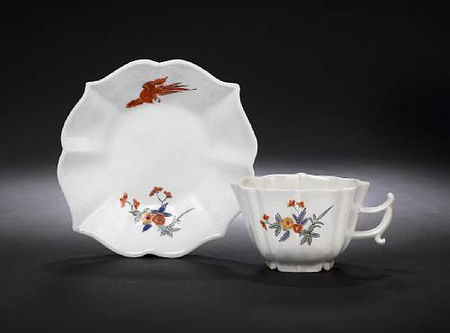
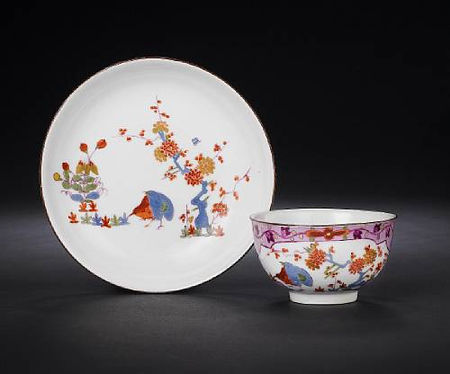

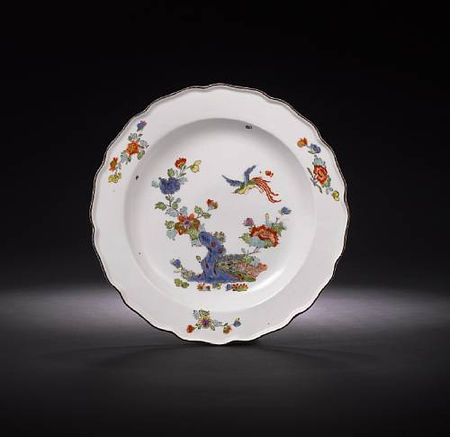



/http%3A%2F%2Fstorage.canalblog.com%2F76%2F60%2F119589%2F65897855_p.jpg)
/http%3A%2F%2Fstorage.canalblog.com%2F39%2F82%2F119589%2F63558760_p.jpg)
/http%3A%2F%2Fstorage.canalblog.com%2F70%2F24%2F119589%2F54577505_p.jpg)
/http%3A%2F%2Fstorage.canalblog.com%2F59%2F94%2F119589%2F54550501_p.jpg)